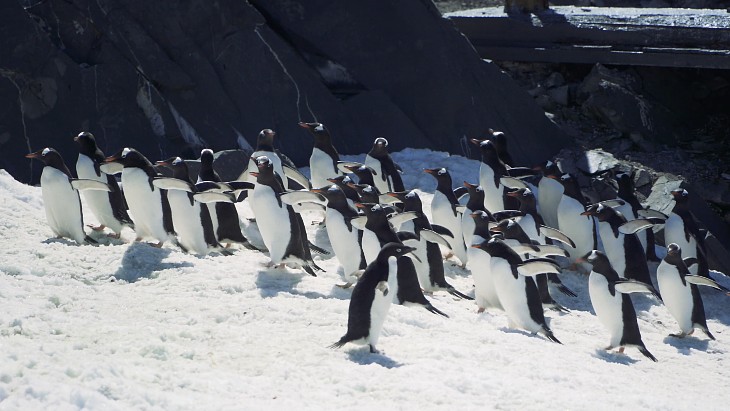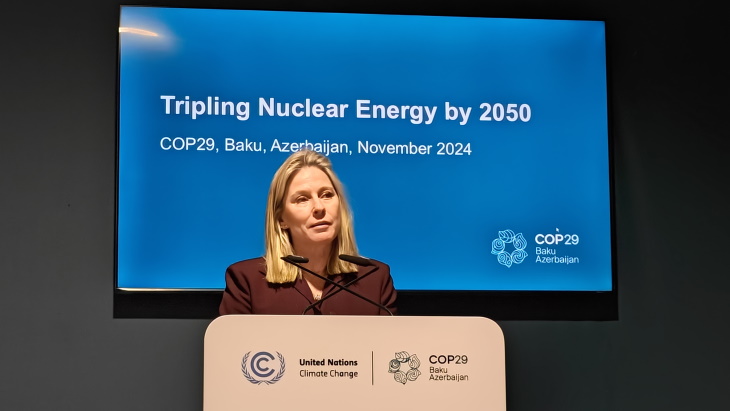Climate target 'very difficult' without nuclear, says IEA chief economist
Wind and solar power are transforming the electricity industry, but not fast enough to put the world on track for the UNFCCC's Paris Agreement target to hold the global temperature increase well below 2°C, according to László Varró, chief economist of the International Energy Agency (IEA). This "climate stabilisation" target needs nuclear power to play a significant role in the low-carbon power mix, Varró told delegates at the Budapest Energy Summit yesterday.
Varró based his comments on the IEA's latest edition of its World Energy Outlook (WEO), which was published on 16 November. The WEO's 450 Scenario shows global nuclear generation output increasing by almost two-and-a-half times by 2040, compared to the present day - from 2535 TWh to 6101 TWh.
The 450 Scenario sets out an energy pathway consistent with the goal of limiting the global increase in temperature to 2°C above pre-industrial levels by limiting concentration of greenhouse gases in the atmosphere to around 450 parts per million of carbon dioxide.
In this scenario, low-carbon energy sources dominate the generation mix. Hydro generates 20%, nuclear 18%, wind 18% and solar PV 9%. Fossil fuel generation declines sharply, with gas supplying 16%, coal 9% and oil 1%. The remaining 9% is supplied by a range of other low-carbon sources.
"Some NGOs love to hate nuclear, but even with the nuclear renaissance, you'd have to push wind and solar to the limit," he said. "If you want to do it without nuclear, it's technically possible, but incredibly ambitious." There are "unanswered questions" about how a 100% renewable system would work , he said. These include whether large-scale transmission development would have social acceptance and to what extent flexible demand response is scalable to a high level.
"China is putting a new nuclear reactor online on average once every quarter," he said, while Russian President Vladimir Putin has overseen the signing of contracts for 36 Russian nuclear units. "I definitely don't believe all these 36 will be actually built, but several will be because for some countries those Russian nuclear deals will prove to be quite attractive for their development."
The biggest growth story in the electricity industry last year, however, belonged to renewable energy, he said.
As well as in nuclear power, China is investing heavily in large hydro, wind and solar power. There is a "genuine chance", he added, for Africa to be "electrified in a low-carbon fashion", through a combination of large hydro power plants, decentralised solar and, in some African countries, wind power.
Notably, the USA has not only cheaper gas but also cheaper wind and solar than Europe does, he said. In addition to natural resources, US renewable deployment is driven by a "favourable taxation environment for wind and solar, which enjoys bipartisan support, and by large US non-energy corporations, such as Apple, leading investment in renewable energy".
Paris Agreement
The entry into force last month of the Paris Agreement is the "good news", Varró told the conference in Budapest, while the "bad news is that it creates a floor for the ambition and not a ceiling". Individual country commitments to cut their CO2 emissions "do not add up to climate stabilisation, but are in fact extremely far from that", he said. "These commitments will need to be ratcheted up and that process is going to be quite challenging. There is absolutely no room for complacency.
"Over the last 25 years, we've had the Rio Earth Summit, the Kyoto Protocol, the Copenhagen Agreement, books, films, Hollywood stars dedicated to climate change and sustainability and yet the average carbon intensity of the energy system has increased," he said.
The WEO's New Policies Scenario sees a very slight increase in global coal and oil, he said, "but that's within the margin of error for the projections, and therefore negligible growth".
This scenario takes account of broad policy commitments and plans that have been announced by countries, including national pledges to reduce greenhouse-gas emissions and plans to phase out fossil-energy subsidies, even if the measures to implement these commitments have yet to be identified or announced.
Natural gas on the other hand is "doing rather well" outside Europe in Asia and Latin America and is "booming" in North America and the Middle East. Natural gas is like the insurance salesman of the electricity industry, he said, since it is often the answer to the 'What if?' questions, such as what to use to replace a coal plant closed for environmental reasons.
"If every single promise to the Paris Climate Change summit was kept - no one was bluffing, no one chickens out - then we get almost stagnation of CO2 emissions - an average annual increase of only 150 million tonnes. That sounds very promising but, unfortunately, modern climate science says there is a huge difference between stabilising emissions and stabilising the climate," he said.
"Stabilising emissions is like driving towards a cliff at full speed and taking your foot off the accelerator. You have slowed down, but you are still heading towards the cliff. Stabilisation of the climate means the elimination of CO2 emissions to achieve a stable atmospheric concentration of CO2."
That will require "radical decarbonisation" over the next 20 years.
"By 2030, 14 years from now, we'll need to find more than ten billion tonnes of additional emissions reductions on top of the Paris Agreement submissions," he said.
"In other words, we will need to find ten European climate energy packages. Whether it is the United States or Europe that is going to lead is a meaningless question, given the scale of the challenge. Everybody has to lead and that's for the 2 degrees scenario."
The "fine print" of the Paris Agreement includes the even tougher ambition of a limit to 1.5°C. That is going to require "something like a war economy", he said, comparing the scale of the challenge to Winston Churchill's call in 1940 for the British manufacturing industry to turn its efforts to building 100,000 airplanes. "The 2 degrees target is just at the borderline of what might be achieved while maintaining consumerist capitalism - and that's only if we do it really smartly."
Varró, a Hungarian national, succeeded Fatih Birol as the Paris-based organisation's chief economist at the beginning of this year. Birol took over as IEA executive director in September 2015.
Researched and written
by World Nuclear News

_99697.jpg)

_53540.jpg)





_66488.jpg)


